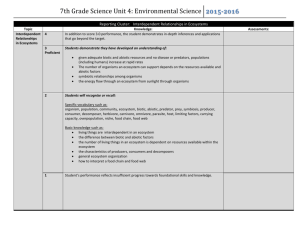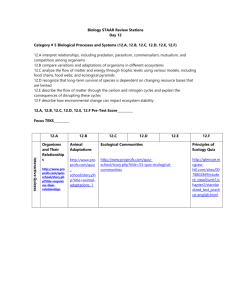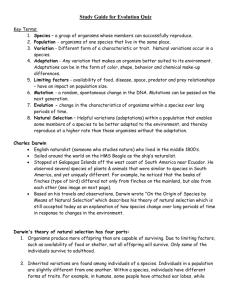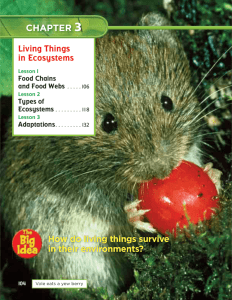Chapter 6 Changes in Ecosystems Notes
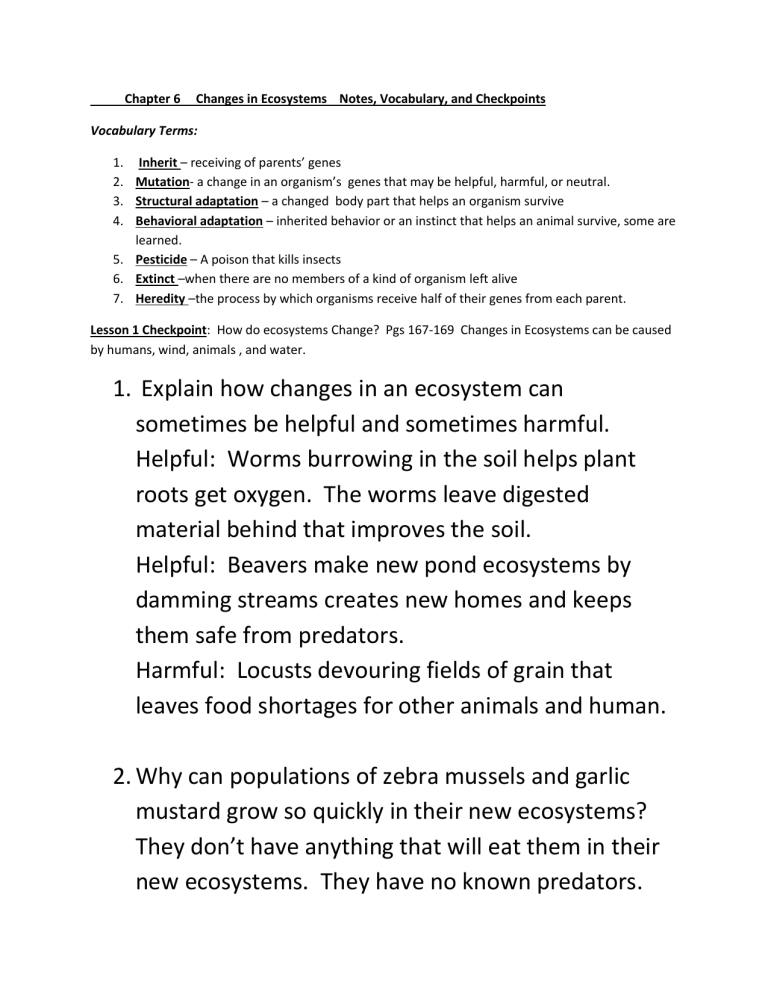
Chapter 6 Changes in Ecosystems Notes, Vocabulary, and Checkpoints
Vocabulary Terms:
1.
Inherit – receiving of parents’ genes
2.
Mutation- a change in an organism’s genes that may be helpful, harmful, or neutral.
3.
Structural adaptation – a changed body part that helps an organism survive
4.
Behavioral adaptation – inherited behavior or an instinct that helps an animal survive, some are learned.
5.
Pesticide – A poison that kills insects
6.
Extinct –when there are no members of a kind of organism left alive
7.
Heredity –the process by which organisms receive half of their genes from each parent.
Lesson 1 Checkpoint: How do ecosystems Change? Pgs 167-169 Changes in Ecosystems can be caused by humans, wind, animals , and water.
1.
Explain how changes in an ecosystem can sometimes be helpful and sometimes harmful.
Helpful: Worms burrowing in the soil helps plant roots get oxygen. The worms leave digested material behind that improves the soil.
Helpful: Beavers make new pond ecosystems by damming streams creates new homes and keeps them safe from predators.
Harmful: Locusts devouring fields of grain that leaves food shortages for other animals and human.
2.
Why can populations of zebra mussels and garlic mustard grow so quickly in their new ecosystems?
They don’t have anything that will eat them in their new ecosystems. They have no known predators.
3.
How do beaver ponds help the beaver? How do they affect other organisms? Ponds protect the beavers from predators. Ponds affect other organisms by flooding an old habitat, but help other organisms by creating a new habitat.
Humans changes ecosystems with housing and industry development, throwing out garbage, and by introducing new plants and animals eg: zebra mussels, garlic mustard plants.
Americans throw away over 200 million tons of garbage a year.
Acid rain changes ecosystems - it is rain that has absorbed pollutants.
4.
Cause and Effect: What is the effect of people introducing new species to an area?
New species can prevent other organisms from meeting such needs as water, sunlight, food, or space.
Lesson 2 Checkpoint: How do species change? Pgs. 170-173 Parents in every species pass traits to their offspring. Traits of species may change and may help the species survive. Because offspring inherit genes from both parents, they differ from both parents as well.
1.
What are some characteristics that are determined by DNA? The number of legs, fur, organ systems, placement of eyes.
What are some characteristics that are determined by the ecosystem? Organisms won’t grow well if there isn’t enough food and water or if the climate is too hot or cold. The color of an organism can be affected by what it eats. eg. flamingos
2.
How are behavioral adaptations like structural adaptations? Both adaptations are inherited and help that organism to survive.
How are behavioral and structural adaptations different? Behavioral adaptations are not parts of the body like structural adaptations are.
3.
What are two reasons that an animal will not have the same DNA as its mother?
Each animal gets only half of its DNA from each parent. Mutations may also change an animal’s
DNA.
Examples of structural adaptations: hummingbird beak, suction cups on frog’s feet, webbed feet of geese, pheasant’s color hides it in the grass, especially the females brownish color.
Examples of behavioral adaptations or instincts: They way a barn swallow makes its nest out of dirt and mud, Lemmings migrate, musk oxen circle around their calves when danger is near, deer and raccoons adapt to living near towns and cities.
Lesson 3 Checkpoint How do changes cause more changes? Pgs 174-177 Living things live together in a system where one change may affect many organisms. Other changes can happen as a result.
Changes in behavior of animals may happen because of changes in the kind or numbers of other animals in their ecosystem. 1. Having a dog in the back yard has caused the rabbits and squirrel population to move to another back yard. 2. Having wild cats causes song birds to move away from them. 3. Having more hog confinement has led to an increase in the turkey vulture population in Rock Rapids because they scavenge on dead pig carcasses. Also we have an increase in the bald eagle population for the same reason.
1.
Explain how a species of mosquitoes can become adapted to having pesticides in their ecosystem.
Changes in populations: Mosquito were sprayed with pesticides. Some mosquito developed adaptations to the pesticide and past it on to their offspring. The offspring may have the same genes that will allow them to live and reproduce.
Bacteria have developed adaptations to living around antibiotics.
2.
What do fossils teach us about extinction? Fossils teach us that a wide variety of organisms has become extinct throughout history. They also give us clues about past ecosystems and why some plants and animals survive well and others do not. Dodo Birds, passenger pigeons.
When changes occur in an ecosystem, some organisms migrate to a place where conditions are more favorable.
3.
Which is more likely to develop adaptations to a changing ecosystem: a population that has many mutations or a population that has few mutations?
A population that has many mutations will be able to survive better in a changing ecosystem.
4.
Cause and Effect: What was the cause of the bald eagle population getting smaller?
The pesticide DDT made the bald eagle eggs’ shells too thin, so fewer bald eagles hatched.


